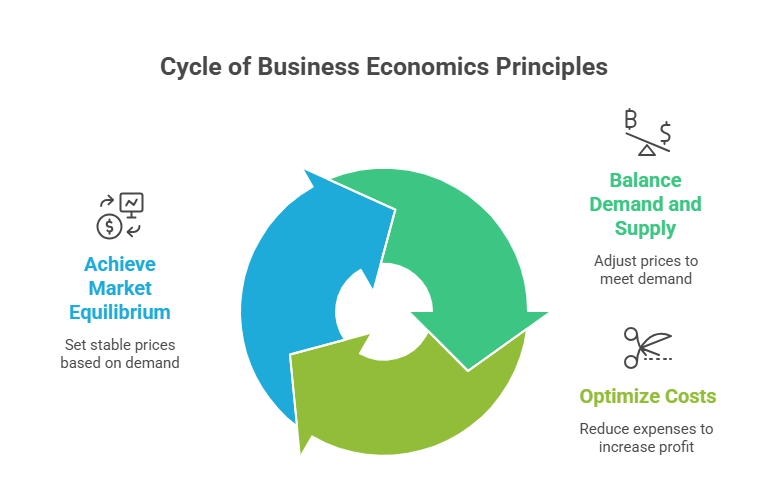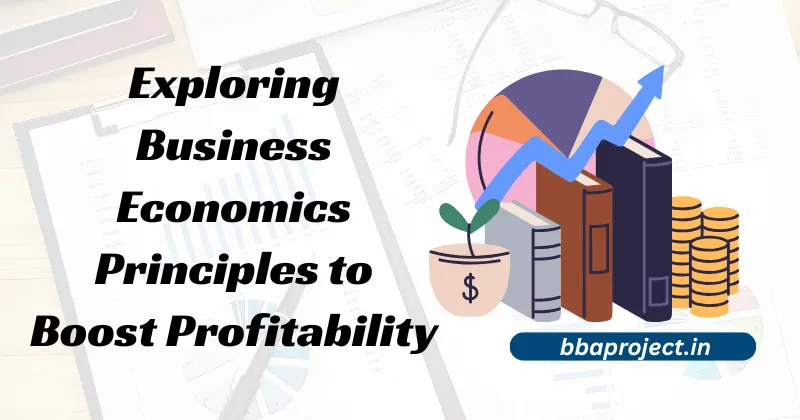Just consider having a tiny store in which any price or cost-cutting decision can either make or mar the profit. That’s Business Economics for you, giving you the framework for making the right decisions and creating Profitability. Whether you are a commerce student, appearing for exams or entering a business career, studying Business Economics helps you make markets work for you, making better use of the resources and improved financial performance. In this primer, the basics of Business Economics are discussed along with applications and implementation in real-life scenarios along with easy-to-understand examples for the students to score in projects and jobs and generate long-lasting Profitability.
What is Business Economics and Its Role in Profitability
Business Economics is the application of economic principles by businesses in making decisions aimed at maximizing Profitability. It integrates the use of demand and supply and cost analysis towards the pricing, production and resource allocation decisions. For Student readers, the subject forms a foundation of the business economics curriculum, tested by numerical questions (e.g. working out the best price) and theory questions (e.g. describing the nature of the market). It’s also a useful real world application in internship work, where you may work out a shop’s costs in advising on profit-increasing strategies.
In India’s competitive business environment, Business Economics assists companies in overcoming challenges such as increasing costs or shifting consumer tastes. For instance, a retail store can apply demand analysis in the setting of suitable price rates appealing to customers and recovering expenses. Mastering Business Economics allows you to suggest strategies increasing Profitability, such as price reduction in order for sales volumes. Example: The owner of a shop employs cost analysis and cuts expenses by 10%, recovering a profit of ₹50,000 a year, a skill students can use in projects or in the workplace.
Key Principles of Business Economics

Business Economics rests on key principles that guide decision-making for Profitability. Here are the main ones:
- Demand and Supply decides how quantities and prices align in a market. When demand for a commodity increases, firms can sell at a higher price and earn more profit. For instance, a store selling umbrellas during monsoons can increase price as the demand is high.
- Cost Analysis studies fixed and varied expenses in order to make maximum spending. A firm may minimize varied expenses such as packing in order to cut expenses.
- Market Equilibrium is a point at which supply and demand intersect in setting fixed price rates. For example, a vegetable seller adjusts price according to daily demand so the sales are constant.
Example: A grocery store optimizes price for 1,000 units sold monthly at ₹50 by reducing packaging expenses by 5%, thereby reducing costs by ₹10,000.
Key principles:
- Demand and Supply: Balances price and quantity. Example: Raise the price of high-demand items.
- Cost Analysis: Reduces costs for profit optimization. Example: Optimize packaging costs for a store.
- Market Equilibrium: Provides pre-determined prices. Example: Charge prices in line with consumer demand.
- Exam Tip: Learn using examples for theory questions.
Applying Principles to Enhance Profitability
Business Economics tenets increase Profitability directly by informing strategic choices. With demand and supply, you can price optimally. In a project work, you can consider a retailing business and advise a 10% reduction in price in order to expand sales by 20%, stirring up profits. The analysis of cost provides the basis for areas of cost reduction, such as purchase of cheaper raw materials while maintaining the same quality. Equilibrium in the market helps business firms not to overstock or undersell and enjoy stable revenue.
These principles apply in real-life professional decisions in the workplace. The manager can apply cost analysis in costing reduction for a 15% increase in margins.
Numerical Example: The shop lowers the price from ₹100 to ₹90 (10% reduction), sales increase from 1,000 units to 1,200 units (20% rise in sales), and revenue increases from ₹1,00,000 to ₹1,08,000. Business Economics application increases project quality and professional deliverables and stimulates Profitability.
Key applications:
- Pricing Strategies: Set prices based on demand. Example: Reduce price for increasing snack sales.
- Cost Optimization: Cut down unnecessary expenses. Example: Sourcing lower-cost materials for a store.
- Exam Tip: Link principles to profitability in case questions.
Using Business Economics in Academic Projects and Professional Settings
Use Business Economics in school projects and work-place assignments for Profitability. In a school project at a hypothetical business setting like a retail outlet, use demand and supply for making price suggestions. Suggest a price cut for high-demand items for increased sales. Example: A school project recommends a 5% price cut in the price of snacks for a 10% sales and profit increase by ₹20,000 a month. In work-place internships, you can study a start-up’s spending and suggest savings like getting the suppliers down for a spending cut of ₹30,000 a year.
Numerical Example: The internship assessment finds a business adds profit by ₹40,000 by controlling costs through bulk purchases, confirming the value in cost analysis. These applications undergird projects and prep you for finance, marketing, or management careers.
Key applications:
- Project Analysis: Recommend pricing strategies. Example: Recommend price cuts for a retail outlet.
- Professional Responsibilities: Maximize profits by managing costs. Example: Negotiate a startup’s vendor agreements.
- Exam Tip: Explain applications using examples in viva.
Overcoming Challenges in Applying Business Economics
Applying Business Economics can be challenging for Students. Understanding complex principles like market equilibrium can be tough. Simplify by studying real-world examples, like how a vendor adjusts prices daily to balance supply and demand. Example: A shop sets vegetable prices to sell 100 kg daily, avoiding overstock. Limited data for projects is another hurdle; you might lack sales figures. Use hypothetical scenarios or secondary sources like market reports. Misapplying principles, like confusing fixed and variable costs, is common. Review definitions—fixed costs (e.g., rent) don’t change, variable costs (e.g., materials) do.
Numerical Example: A project incorrectly calculates profits by considering rent as a variable cost; the error gets corrected by saving ₹15,000 in analysis mistakes. Time limitations in internships may restrict analysis. Emphasis upon major principles, such as demand, for speedy solutions.
Key challenges and solutions:
- Complex Principles: Learn simple examples. Example: Learn vendor pricing for equilibrium.
- Restrictive Data: Utilize hypothetical or secondary data. Example: Generate demand by simulating market reports.
- Exam Tip: Tackle aspects of descriptive responses for clarity.
Table: Business Economics Principles for Profitability
| Principle | Impact | Application |
|---|---|---|
| Demand and Supply | Sets optimal prices | Adjust prices for demand |
| Cost Analysis | Reduces expenses | Cut variable costs |
| Market Equilibrium | Stabilizes revenue | Balance supply and demand |
Conclusion
Business Economics helps Students lead towards Profitability by making use of the application of the basics like demand analysis, cost analysis, and market equilibrium. Proficiency in such tools helps you create effective projects, crack exams, and fulfill work obligations. Gain access to this guide and unlock the potential of Business Economics towards a flourishing business profession.
Understanding Valid Contracts and Types of Contracts Under the Indian Contract Act
👨💼 Author: BBAProject Editorial Team
✍️ The BBAProject Editorial Team comprises business graduates and educators dedicated to creating practical, syllabus-based learning resources for BBA students.
⚠️ Please Note: Articles published on BBAProject.in are well-researched and regularly updated. However, students are advised to verify data, statistics, or references before using them for academic submissions.

